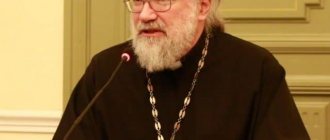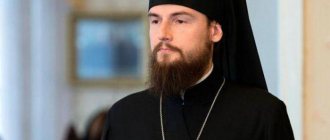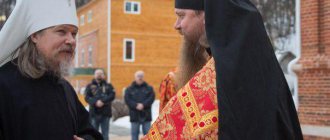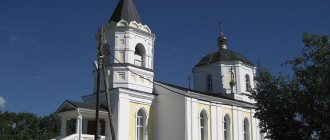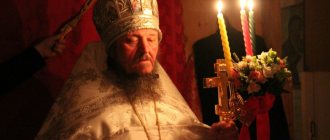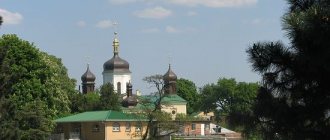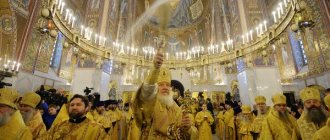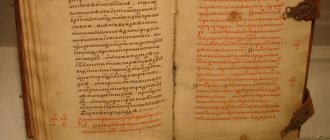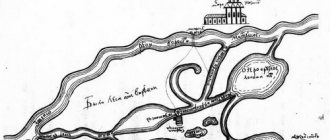| Archimandrite Peter | |||||||||||||||
Archimandrite Peter Honored Artist of Russia. He was at the origins of several musical groups, among which the most notable are the Moscow Instrumental Chapel created by him in 1978 at the Moscow Regional Philharmonic and the male chamber choir “Blagozvovnitsa” founded in 1997, that is, after entering the path of priesthood[2]. | |||||||||||||||
Biography
Born on November 20, 1938 in the village of Rep-Plata, Kursk region, in the family of Nikolai Ivanovich and Evdokia Grigorievna Afanasyev, who were choir singers in the local cathedral church of the Archangel Michael. On his birthday, he was baptized by the parish priest in honor of Alexander of Thessalonica[2].
In the fall of 1945, the family moved to Moscow. Since childhood I sang in the choir[2]. According to his own recollections: “Everyone in the family were believers - and I was a believer. I studied like everyone else. At school, I was scolded for going to bless Easter cakes, while my peers were pioneers. At a very early age, from a young age, I became acquainted with the Trinity-Sergius Lavra”[3].
In 1960 he married Evgenia Dmitrievna Andreeva. Alexander and Eugene were married by Schema-Archimandrite Ambrose (Ivanov), who had a significant impact on Alexander’s spiritual development[2].
After graduating from a special music school in the domra class, where he also played the double bass, he was drafted into the army in 1963. Being by this time already a family man, he applied to the USSR Ministry of Defense with a request to be transferred to a unit located closer to his wife and daughter, as well as with a request to allow him to combine military service with studies at the Moscow State Conservatory[2].
In 1965, he completed his military service and at the same time successfully completed his studies at the conservatory in the double bass class. In 1965-1975, Alexander Nikolaevich was the head of the conducting class at the Music College named after. Gnesins. In 1975, he took a conducting course there[2].
In 1972-1992 he was the artistic and musical director of the Moscow State Philharmonic, received the title of professor, Honored Artist of Russia[2].
He became friends with the gifted regent Archimandrite Matthew (Mormyl), and actively participated in the recording of the first discs of church chants of the Trinity-Sergius Lavra choir between 1968 and 1978[2]. Since 1985, he was regent and choirmaster at the Trinity Cathedral in the city of Alexandrov[4].
On February 16, 1989, at the age of 51, Metropolitan Juvenaly (Poyarkov) of Krutitsky and Kolomna was ordained to the rank of deacon[5], after which he served in the Holy Trinity Novo-Golutvin Kolomna Convent[2].
On December 10, 1991, the same bishop ordained him to the rank of presbyter, and continued to serve there until 1992[5].
From 1992 to 1994 he was the head of the department of church singing at the Russian Orthodox Institute. St. ap. John the Evangelist[6]. At the same time, he studied at the Moscow Theological Seminary, which he graduated from in 1994[6].
Since February 1995, he served as a cleric at the Patriarchal Metochion in the Vysoko-Petrovsky Monastery in Moscow[5].
In 1997[7], Priest Alexander was appointed rector of the Church of the Savior of the Image Not Made by Hands of the Patriarchal Compound of the former Zaikonospassky Monastery of the Year in Moscow[2]. In the same year, at the Church of the Savior Not Made by Hands of the former Zaikonospassky Monastery, he founded the male chamber choir “Blagozvonnitsa”.
On June 22, 1999, by decree of Patriarch Alexy II, the Patriarchal Metochion of the Church of St. Nicholas of Myra was formed in the village of Shostye, the rector of which was appointed priest Alexander Afanasyev[8].
In 2000, he was tonsured a monk with the name Peter in honor of St. Peter, Metropolitan of Moscow. At the same time, he also took monastic vows.[2] “And it’s good that I accepted it at this time, at this age. I was already a mature person, I no longer tolerated the kind of passions that 17-18 year old children experience, although I had endured it before and knew what it was.”[3].
On September 6, 2003, in connection with his 65th birthday, Patriarch Alexy II awarded the Order of the Blessed Prince Daniel of Moscow, 3rd degree. Newspaper “Russian Messenger”: “Father is known in many parts of not only Moscow, but throughout Russia as a prayer book for our country and the Russian people and a wise mentor. Both old and young come to him for confession and for advice.”[9]
On July 7, 2005, Patriarch Alexy II appointed rector of the Patriarchal Metochion of the Church in the name of the Blessed Prince Alexander Nevsky in the village of Akatovo, Klinsky district, Moscow region[10].
On April 6, 2006, in the Moscow Church of St. Nicholas in Zvonary, he was elevated to the rank of abbot by Patriarch Alexy II of Moscow and All Rus'[11].
In the same year, he was appointed rector of the Church of the Three Saints in the village of Volynshchino, Ruza district, Moscow region[5].
On March 5, 2010, by a resolution of the Holy Synod, he was appointed abbot of the Moscow Zaikonospassky stauropegial monastery, opened and separated from the Patriarchal metochion of the former Zaikonospassky and Nikolsky monasteries in Kitai-Gorod[12].
On April 19, 2011, in the upper church in honor of the icon of the Mother of God “Joy of All Who Sorrow” of the monastery Cathedral of the Savior Not Made by Hands, Patriarch Kirill presented Abbot Peter with the abbot’s staff, and also awarded him the right to wear a cross with decorations[13].
On May 1, 2013, in the upper church in honor of the icon of the Mother of God “Joy of All Who Sorrow” of the Spassky Cathedral of the monastery, he was elevated to the rank of archimandrite by Patriarch Kirill of Moscow and All Rus'[14]
On May 29, 2013, by the decision of the Holy Synod, the Patriarchal Metochion of the Church of the Holy Blessed Prince Alexander Nevsky in the village of Akatovo was transformed into a stauropegic convent, the abbess of which was nun Antonia (Minina)[15].
On May 26, 2014, an international scientific and practical conference “Koreans and Orthodoxy. To the 150th anniversary of Koreans living in Russia,” at which he made an opening speech[16].
On December 24, 2015, by the decision of the Holy Synod, the patriarchal metochion of the Church of St. Nicholas of Myra in the village of Shostye was transformed into the St. Nicholas Shostye Stavropegial Convent, the abbess of which was appointed nun Neonilla (Frolova)[17].
According to Hieromonk Hermogenes (Korchukov): “Archimandrite Peter, who enjoys enormous authority, never used the power of his pastoral word beyond measure. He avoided publicity, humbly hiding all his ranks, achievements and, especially, spiritual gifts. He did not accept praise or exaltation, and did not like it when his talents were mentioned - from artistic to economic and administrative. Meanwhile, with the blessing of Father Peter, the Higher Znamensky Theological Courses, a Sunday school, the unique Moscow Slavic-Korean community, the Spassky Orthodox Youth Center, the Missionary Center “Bozhya Niva” were created and developed at the monastery, conferences were held and books were published.”[5].
He died on April 11, 2021, at 7 a.m., in Moscow, at the age of 78. On the same day, the chairman of the Synodal Department for Monasteries and Monasticism, Archbishop Feognost (Guzikov) of Sergiev Posad, performed a litany for the newly deceased Archimandrite Peter in the chapel of St. Nikon of Radonezh Trinity Cathedral of the Trinity St. Sergius Lavra[6].
On April 13, at the Zaikonospassky Monastery, Archbishop Feognost (Guzikov) of Sergiev Posad led the funeral service. He was buried in the right aisle of the holy great martyr and healer Panteleimon of the Church of the Holy Blessed Grand Duke Alexander Nevsky of the Holy Trinity Alexander Nevsky Stauropegial Convent [18].
Youth. War. Military service
Pyotr Petrovich Kucher was born on July 11, 1926 in the village of Klinovoe, Bakhmut district, Yekaterinoslav province (Dnepropetrovsk region, Ukraine).
In 1943, at the height of the Great Patriotic War, when he was 17 years old, he was called up to serve in the active army.
July 11, 1926
Peter Kucher's birthday
As a conscript with incomplete secondary education, he was sent to the regimental school.
Three months after entering school, on December 5, 1943, Pyotr Petrovich took the oath near Dnepropetrovsk, Sinelnikovo station.
After graduating from the regimental school on June 11, 1944, as an artillery sergeant, he was sent as part of the 57th Army to the 3rd Ukrainian Front.
Petr Petrovich participated in the liberation of such countries as: Moldova, Bulgaria, Romania, Hungary, Yugoslavia, Austria and Czechoslovakia.
For participation in hostilities he received such awards as the Order of Glory, III degree, Order of the Patriotic War, II degree, medals “For Courage”, “For the Capture of Vienna” and others.
Father Peter in military decorations
With the end of the war, Pyotr Petrovich did not finish his military service; he was demobilized in 1950 as a major, having served in the East Siberian District near Irkutsk.
There is very little information about the subsequent years of his life, but from it it can be established that until 1975, Pyotr Petrovich worked as a veterinarian and was married.
Revival of the Zaikonospassky Monastery
From the very beginning of his service in the former Zaikonospassky Monastery, he sought to revive it. Like himself about [3]. He gathered the brethren gradually, mainly from parishioners[7]
He fought for the objection to the former monastery of its once seized premises with the aim of reviving the Zaikonospassky monastery[19]. This was hampered by a conflict with the Russian State University for the Humanities, which occupied part of the former monastery premises[20][21]. In 2004 o[22][23]. He believed that “The Zaikonospassky Monastery and the St. Nicholas Monastery must be preserved not only for the Church, but also for the people. The Slavic-Greek-Latin Academy in the Zaikonospassky Monastery is a national treasure necessary for the future of Russia. It’s time to pay closer attention to the government and the public not only to the preservation, but also to the reconstruction of monasteries in order to preserve the historical cradle of spirituality and Russian education”[24]. By a decree of the Moscow government of November 14, 2004, several premises on Nikolskaya Street were transferred to the community of the Spassky Church of the former Zaikonospassky Monastery for free use[25].
The buildings of the former Zaikonospassky Monastery and the Slavic-Greek-Latin Academy came to the center of media attention in April 2008, when it turned out that during the reconstruction of the transition from the Ploshchad Revolyutsii station to Nikolskaya Street, three underground floors were illegally built. This led to the threat of collapse of the Zaikonospassky Monastery[26]. In May of the same year, it was announced that ground subsidence and tilting of the Spassky Cathedral had occurred[20][24]. The story of the “excavations” near the Kremlin caused a wide public outcry. As the inspection showed, the construction, which threatened to collapse the monastery buildings, was illegal, and after some time it was stopped[21].
The official revival of the monastery in 2010 essentially did not change anything. Where Abbot Peter wanted to make cells for monks and classrooms, the premises of two federal state unitary enterprises were located. The access regime of unitary enterprises did not allow the monastery to begin to operate as a full-fledged monastery. In his letter to the Prosecutor General of the Russian Federation Yuri Chaika, Abbot Peter complained that the leadership of the Russian State Humanitarian University ignores the current legislation and simultaneously accuses the monastery of a raider takeover. A number of media outlets, at the instigation of the university management, dubbed the monastery “raiders in robes”, and the university itself as “victims of obscurantism”[27].
However, subsequently the monastery and the Russian State University for the Humanities moved from confrontation to cooperation. On December 20, 2011, the first joint event took place at the Historical and Archival Institute of the Russian State University for the Humanities - a ceremonial meeting dedicated to the 300th anniversary of the birth of M.V. Lomonosov, held by the monastery, the Moscow Society of Local Lore and the Department of Local History and Historical and Cultural Tourism of the Institute. Based on its results, a collection of materials was published[28]. According to Abbot Peter, “candidates and doctors of sciences calmly communicated with me there”[3].
In 2014, the bell tower, built in 1902 by the architect G. A. Kaiser and partially destroyed during the Soviet years, was restored[29].
Until the end of his life he was never able to obtain premises for the monastery. As Hieromonk Daniel (Konstantinov) noted in August 2021: “The brethren live in two groups in two buildings. Moreover, the windows of these premises overlook Nikolskaya Street. We have nothing else at this time, because we only own the temple itself. In the courtyard there are several organizations, the Russian State Humanitarian University (formerly the Historical and Archival University), whose students walk through our territory every day. There are also utility exits from the post office, women’s shoe store, and restaurant.”[7].
Ordination and beginning of worship
Peter Petrovich (hereinafter referred to as Father Peter) began his divine service on August 10, 1975, when he was ordained a priest by Archbishop Leonid of Riga and Latvia and appointed priest of the Daugavpils Cathedral.
Daugavpils Cathedral of Saints Boris and Gleb. Father Peter Kucher served here
From May 1979 to April 1991 he served as a spiritual mentor in the Spaso-Preobrazhenskaya Hermitage from the Riga Holy Trinity Convent. One of the places of pilgrimage in the Soviet Union.
1991
this year Peter was invited to restore the Zadonsk St. Tikhomirovsky Monastery
In the spring of 1991, Father Peter was invited to restore the Zadonsk St. Tikhomirovsky Monastery, the buildings of which were transferred to the Church in April of the same year, the condition of which was catastrophic and required almost complete upholding again.
By April 1993, the majestic Trinity Cathedral, bell tower, and complex of monastery buildings had been restored, the miraculous spring of St. Tikhon of Zadonsk had been renovated - fonts had been installed and a chapel had been built.
In 1996, after the appointment of a new abbess to St. Tikhon’s Monastery, a conflict arose between Father Peter and the diocesan leadership.
The reason was the lack of mutual understanding and different views on the management of the monastery. The result of this confrontation was the refusal to hold the Easter service, which the diocese insisted on.
After this and several other conflict situations, Father Peter appeared before the leadership of the Vladimir diocese, where he was given time to repent for canonical violations, a month after which he returned to the Moscow Patriarchate.
Musical activities
In 1978, he founded the “Instrumental Chapel” orchestra at the Moscow Regional Philharmonic, which included graduates of the Moscow Conservatory and the Gnessin Academy. The orchestra became one of the first musical groups in the USSR to turn to the authentic style of performing Baroque music in Russia[30]. The musicians' interest in historical performance allowed them to implement many interesting programs, including with such masters of baroque music as Tatyana Grindenko, Alexey Lyubimov, Oleg Khudyakov. A distinctive feature of the “Instrumental Chapel” is a careful approach to the style of performance, the revival of the culture of free music-making and an appeal to the traditions of ensemble playing inherent in the practice of the 17th-18th centuries[31]. He directed the “Instrumental Chapel” until 1995[32].
In November 1997, he created the male chamber choir “Blagozvonnitsa” at the former Zaikonospassky Monastery[33]. According to the memoirs of Georgy Syzrantsev, “the team did not immediately begin concert activities, it did not immediately have premises for the rehearsal process, it did not immediately have the right staff and composition <…>. At first there were 5-6-10 people who gathered for Orthodox holidays”[34]. The repertoire of the group consisted of classical spiritual chants, works of modern composers, folk songs, songs of the war years[35][36][37]. The choir has toured throughout Russia and abroad. Recordings of the choir's works are heard on the radio, some of them were released on audio cassettes and CDs[33].
Bogolyubsky Monastery. History of "Grad Kamen"
The Bogolyubsky Women's Orthodox Monastery is located in the village of Bogolyubovo, Suzdal district of the Vladimir region, belongs to the Vladimir and Suzdal diocese of the Orthodox Church.
Bogolyubsky Monastery is the heart of “Grad Kamen”. Father Peter Kucher serves here
It is located on the territory of the palace-castle of Andrei Bogolyubovo, who in the middle of the 12th century founded a country residence - the “city of stones” Bogolyubovo. In addition to the castle itself, a temple was also erected here in honor of the Nativity of the Virgin Mary.
The ensemble of buildings of the princely residence included: a two-story stone palace, a ciborium, a castle and stone walls. This entire complex of buildings - the only one that has survived to our times - dates back to the period before Mongol Rus.
Reconstruction of the castle of Andrei Bogolyubsky. On the territory of this castle, the Bogolyubov Monastery was established, where Father Peter Kucher serves
The monastery on the territory of the castle was built at the beginning of the 13th century, by the successors of Prince Andrei. From the 17th to the 20th centuries, the monastery was put under the control of the Vladimir bishops, and a cathedral was also built in honor of the Bogolyubskaya Icon of the Mother of God.
In 1923, the monastery was closed and transferred to the local executive committee; later the entire ensemble became the property of the museum department. In 1991, the ensemble was transferred to the Church.
Notes
- Outpost of Father Peter // monasterium.ru, April 25, 2017
- ↑ 1234567891011
Singing of the heart // Monastic Bulletin, April 11, 2016 - ↑ 1234
Hegumen Peter (Afanasyev): We must love everything that the Lord gives // Tatyana’s day - Archim. Peter (Afanasyev) // alexandrov-obitel.ru, 04/13/2016
- ↑ 1 2 3 4 5 Hieromonk Hermogenes (Korchukov)
Archimandrite Peter (Afanasyev) (11/20/1938-04/11/2016) // e-vestnik.ru, May 6, 2016 - ↑ 123
Archimandrite Peter (Afanasyev), the abbot of the Zaikonospassky stauropegial monastery, reposed in the Lord // Patriarchy.ru - ↑ 1 2 3 Hieromonk Daniel (Konstantinov).
Time for prayer and time for work: organization of the daily routine of the brethren in connection with the peculiarities of life in the city
(unspecified)
.
Monastic Bulletin
(October 10, 2017). - The Feast of the Nativity of Christ took place in the St. Nicholas Shostiensky Monastery // Monastic Bulletin, January 7, 2016
- Congratulations to Hieromonk Peter (unspecified)
.
www.rv.ru.
_ Russian Bulletin (October 8, 2003). - Akatovo Monastery - Holy Trinity Alexander Nevsky Stauropegic Convent
- Patriarch Alexy celebrated the Liturgy in the Annunciation Cathedral of the Moscow Kremlin / Pravoslavie.Ru (unspecified)
.
pravoslavie.ru
(April 10, 2006). - JOURNALS of the meeting of the Holy Synod of March 5, 2010 // Patriarchy.ru
- His Holiness Patriarch Kirill prayed for Matins of Great Wednesday at the Zaikonospassky Stavropegial Monastery // Patriarchia.ru, April 19, 2011
- Matins of Great Thursday in the Zaikonospassky Monastery in Moscow // Patriarchia.ru, May 1, 2013
- JOURNALS of the meeting of the Holy Synod of May 29, 2013 // Patriarchy.ru
- The international scientific and practical conference “Koreans and Orthodoxy. To the 150th anniversary of Koreans living in Russia" (unspecified)
.
mospat.ru
(May 26, 2014). - JOURNALS of the meeting of the Holy Synod of December 24, 2015 // Patriarchy.ru
- The funeral service for the abbot of the monastery, Archimandrite Peter (Afanasyev) (unspecified)
.
Patriarchia.ru
(April 15, 2016). - Zaikonospassky
Monastery will be restored in the center of Moscow .
Izvestia
(December 19, 2007). - ↑ 1 2
Elena Lebedeva.
Zaikonospassky Monastery (undefined)
.
pravoslavie.ru
(August 29, 2008). - ↑ 1 2
The Zaikonospassky Monastery, closed by the Bolsheviks 90 years ago, will be opened in Moscow
(unspecified)
.
Interfax.ru
(March 6, 2010). - Zaikonospassky and Nikolsky monasteries in Moscow are in critical condition // Church-Scientific, July 15, 2004
- The Patriarchal Metochion in Moscow is in critical condition (unspecified)
.
RIA Novosti
(July 15, 2004). - ↑ 1 2
Illegal underground construction can destroy the Patriarchal Compound near the Kremlin
(unspecified)
.
russ.ru.
_ Russian magazine (May 30, 2008). - A. V. Mashtafarov, L. K. Maciel Sanchez.
Zaikonospassky Monastery in honor of the Image of the Savior Not Made by Hands // Orthodox Encyclopedia. - M.: Church Scientific, 2008. - T. XIX: “Message to the Ephesians - Zverev.” — P. 522-527. — 752 p. — 39,000 copies. — ISBN 978-5-89572-034-9. - Moscow Heritage Committee will restore the Zaikonospassky Monastery by 2011 (unspecified)
.
RIA Novosti
(August 12, 2009). - Litigation at the church fence
- “Zaikonospassky Monastery in the history and culture of Moscow: past and present day” (unspecified)
.
moseparh.ru
. Moscow city diocese of the Russian Orthodox Church (December 14, 2018). - Vladimir Anishchenkov.
Zaikonospassky Monastery: abode of wisdom
(undefined)
.
ElitsyMedia
(July 23, 2019). - Symphony Orchestra of the Moscow Regional Philharmonic "Instrumental Chapel"
- Chamber orchestra "Instrumental Chapel": cello, double bass, violin - concerts in Moscow 2020-2021
- Chamber orchestra "Instrumental Chapel" | Moscow Easter Festival
- ↑ 12
Zaikonospassky Monastery – Choir of the Blagozvonnitsa - “Chorus “Blagozvonnitsa””. Bright evening with Hierarch. Naum (Salomatin), Anatoly Kislyakov and Georgy Syzrantsev (06.12.2017) - Radio VERA
- The choir of the Zaikonospassky Monastery will perform at the Jerusalem Patriarchate // Patriarchia.ru, September 2, 2008
- CPDS students attended a concert of the male choir “Blagozvonnitsa” (unspecified)
.
seminaria.info
. Kuzbass Orthodox Theological Seminary (May 1, 2018). - A church choir from Moscow went on tour in Romania / News / Dioceses / Patriarchia.ru (unspecified)
.
Patriarchia.ru
(November 5, 2013).
[edit] Sources
- MRPS - Higher Regency Courses
- A church choir from Moscow went on tour in Romania / News / Dioceses / Patriarchy.ru
- ↑ 3,003,013,023,033,043,053,063,073,083,093,103,11 Singing of the heart / Monastic Bulletin
- ↑ 4,04,14,2 Hegumen Peter (Afanasyev): We must love everything that the Lord gives - Tatiana’s day
- ↑ 5,05,15,2 The abbot of the Zaikonospassky stauropegial monastery, Archimandrite Peter (Afanasyev) reposed in the Lord / News / Patriarchy.ru
- The choir of the Zaikonospassky Monastery will perform at the Jerusalem Patriarchate / News / Patriarchy.ru
- The Feast of the Nativity of Christ took place in the St. Nicholas Shostiensky Monastery / Monastic Bulletin
- Zaikonospassky and Nikolsky monasteries in Moscow are in critical condition - News - Church-Scientific
- Akatovo Monastery - Holy Trinity Alexander Nevsky Stauropegic Convent
- Patriarch Alexy celebrated the Liturgy in the Annunciation Cathedral of the Moscow Kremlin / Orthodoxy.Ru
- JOURNALS of the meeting of the Holy Synod of March 5, 2010 / Official documents / Patriarchy.ru
- His Holiness Patriarch Kirill prayed for Matins of Great Wednesday at the Zaikonospassky Stavropegic Monastery / News / Patriarchy.ru
- Matins of Great Thursday in the Zaikonospassky Monastery in Moscow / Photo albums / Patriarchy.ru
- JOURNALS of the meeting of the Holy Synod of May 29, 2013 / Official documents / Patriarchy.ru
- The international scientific and practical conference “Koreans and Orthodoxy. To the 150th anniversary of Koreans living in Russia" | Russian Orthodox Church
- JOURNALS of the meeting of the Holy Synod of December 24, 2015 / Official documents / Patriarchy.ru
- The funeral service for the abbot of the monastery, Archimandrite Peter (Afanasyev) took place at the Zaikonospassky Stavropegic Monastery / News / Patriarchy.ru
Links
interview
- Hegumen Peter (Afanasyev): We must love everything that the Lord gives // taday.ru, January 20, 2012
- Peter: We must learn to live according to the Gospel // nkpress.ru, May 12, 2016
materials
- Sergei Kirillov
Garrison of Father Peter // Monastic Bulletin. 2015. - No. 22 - Krupin V.N.
Singing of the heart: In memory of Archimandrite Peter (Afanasyev) // Russian House: A magazine for those who love Russia. 2021 - No. 6 - P. 49. - Ermogenes (Korchukov), Hierome.
Archimandrite Peter (Afanasyev): 11.20.1938-04.11.2016 // Journal of the Moscow Patriarchate. — 2021. — No. 5. — P. 94-95 - Outpost of Father Peter // monasterium.ru, April 25, 2017
- Canon. Choir “Blagozvonnitsa”: Anatoly Kislyakov and Georgy Syzrantsev. Part 1 // tv-soyuz.ru, December 23, 2017
